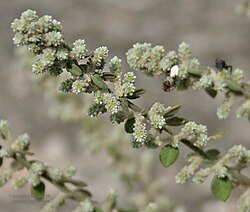Ouret lanata
| Ouret lanata | |
|---|---|

| |
| Aerva lanata var. rotundifolia | |
| Scientific classification | |
| Kingdom: | |
| (unranked): | |
| (unranked): | |
| (unranked): | |
| Order: | |
| Family: | |
| Subfamily: | |
| Genus: | |
| Species: | A. lanata[1]
|
| Binomial name | |
| Aerva lanata | |
| Synonyms[2] | |
| |

Aerva lanata (mountain knotgrass) is a woody, prostrate or succulent, perennial herb in the Amaranthaceae family of the genus Aerva, native to Asia, Africa, and Australia.[1] The plant sometimes flowers in the first year.[3][4]
A. lanata is a common weed which grows wild everywhere in the plains of India. The root has a camphor-like aroma. The dried flowers which look like soft spikes, are sold under the commercial names as Buikallan or Boor. It is one of the plants included in Dasapushpam, the ten sacred flowers of Kerala.
Common names
- Bengali: Chaya.
- Dhivehi: Hudhu huipila
- Duk.: Kul -ke -jar, Khul.
- Hindi:Gorakhbuti or Kapuri jadi.
- Kannada: Bilesuli.
- Malayalam: Cherula.
- Marathi: Kapuri-madhura.
- Punjabi: Bui-kaltan (flowers as sold in bazaars).
- Rajasthani: Bhui.
- Sanskrit: Astmabayda[5]
- Sindhi: Bhui, Jari.
- Sinhalese: Pol pala.
- Tamil: Sirru -pulay -vayr.
- Telugu: Pindi-kura, Pindi-chettu.
- Trans-Indus: Asmei, Spirke, Sasai.
- Swahili: Kinongo
- Akan-Asante bameha
- Abure n-tanfa
- Akye: munongbe
- Baule akopinolé
- Guere (Chiehn) ura ore, wore oré (K&B) wulo wulé (B&D)
Description
Mountain knotgrass is an annual with a branching, somewhat woody root system. The stems are mostly straggling and sprawling and spread widely, sometimes as much as 6 feet (1.8 m) in length. The often stalkless leaves are alternate, oval and 0.5 to 1.5 in (13 to 38 mm) long. They grow from whitish papery stipules with two lobes and red bases. The tiny clusters of two or three flowers grow in the leaf axils. The flowers are about 0.1 in (2.5 mm) long, pink, green or dull white. The flowers are normally self-pollinated. Flowering time is from May to October.[6]
Distribution

A. lanata prefers damper sites than A. javanica and can be found in open forests on mountain slopes, on waste and disturbed ground, deserted cultivation and coastal scrub[3] and at altitudes from sea level to 900 metres (3,000 ft).[5] It is a common weed in arable fields and bare patches of ground.
- Native
- Afrotropic:
- Northeast Tropical Africa: Ethiopia, Somalia
- East Tropical Africa: Kenya, Tanzania, Uganda
- West-Central Tropical Africa: Cameroon, Rwanda, Zaire
- West Tropical Africa: Côte d'Ivoire, Ghana, Liberia, Nigeria, Sierra Leone, Togo, Benin
- South Tropical Africa: Malawi, Mozambique, Zimbabwe
- Southern Africa: South Africa - Natal, Transvaal
- Western Indian Ocean: Madagascar
- Arabian Peninsula: Saudi Arabia
- Indomalaya:
- Indian Subcontinent: India, Sri Lanka
- Malesia: Indonesia, Malaysia, Papua New Guinea, Philippines
- Australasia: Queensland[1]
Uses
This plant is used for food for people and animals. The whole plant, especially the leaves, is edible. The leaves are put into soup or eaten as a spinach or as a vegetable. The plant provides grazing for stock, game and chickens. The plant is used as a traditional medicine for snakebites.[6]
The plant is also used as a talisman against evil spirits, a good-luck talisman for hunters, and a talisman for the well-being of widows.[4]
Antioxidant activity
The aqueous extract of A. lanata stem possess in vitro antioxidant activity.[7]
References
- ^ a b c Germplasm Resources Information Network (GRIN) (1987-04-28). "Taxon: Aerva lanata (L.) Juss. ex Schult". Taxonomy for Plants. USDA, ARS, National Genetic Resources Program, National Germplasm Resources Laboratory, Beltsville, Maryland. Retrieved 2008-04-27.
- ^ "Aerva lanata (L.) Juss. ex Schult. record n° 177". African Plants Database. South African National Biodiversity Institute, the Conservatoire et Jardin botaniques de la Ville de Genève and Tela Botanica. Retrieved 2008-04-27.
- ^ a b Royal Botanic Gardens, Kew. "Amaranthaceae by C. C. Townsend". Flora Zambesiaca. 9 (part:1). Board of Trustees of the Royal Botanic Gardens, Kew. Retrieved 2008-04-28.
- ^ a b Aluka. "Entry for Aerva lanata (Linn.) Juss. [family AMARANTHACEAE]". African Plants. Ithaka Harbors, Inc. doi:10.5555/AL.AP.UPWTA.1_130. Retrieved 2008-04-27.
{{cite web}}: Check|doi=value (help) - ^ a b Robert Freedman (1998-01-20). "Famine Foods - AMARANTACEAE". Purdue University. Archived from the original on 6 April 2008. Retrieved 2008-04-20.
{{cite web}}: Unknown parameter|deadurl=ignored (|url-status=suggested) (help) - ^ a b "Aerva lanata". Medicinal Plants Used For Snake Treatment. ToxicologyCentre.com. Retrieved 2013-12-10.
- ^ Kumar G, Karthik L, Rao KVB (2013). "Phytochemical composition and in vitro antioxidant activity of aqueous extract of Aerva lanata (L.) Juss. ex Schult. Stem (Amaranthaceae)". Asian Pacific Journal of Tropical Medicine. 6 (3): 180–187.
{{cite journal}}: CS1 maint: multiple names: authors list (link)
External links
- "Aerva lanata". Integrated Taxonomic Information System. Retrieved 27 April 2008.
